This was published 7 years ago
Review: Francesco Clemente: Encampment ... a restless spirit lands at Carriageworks
By John McDonald
No contemporary artist could be more elusive than Francesco Clemente, who was born in Italy in 1952 but divides his time between homes in New York and Varanasi in India. Although his output has been voluminous over the past 40 years, it would be hard to point to any single picture and say it was his masterpiece. It's even difficult to isolate a "typical" work, as Clemente is an artist who delights in change and fragmentation. His career doesn't follow a linear progression but seems to continually revisit past series, adding new layers to what he has already built, like fortifications on a wall used as a defence against creative staleness.
In the age-old debate as to whether time flies like an arrow or turns back on itself cyclically, Clemente is in the latter camp. He belongs to the party of the mystics, drawing inspiration from arcane religious traditions; borrowing motifs from Hinduism, Buddhism, alchemy, and the classical thought of Greece and Rome. He once told an interviewer: "The gods who left us thousands of years ago in Naples are still in India."
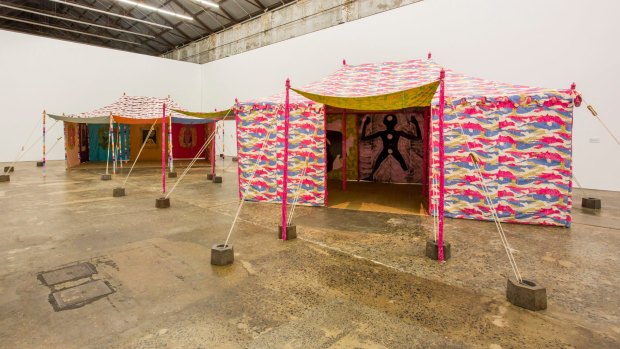
Francesco Clemente's Encampment at Carriageworks. Credit: Anna Kucera
If this sounds too cosmic for comfort, it's only one aspect of the enigma that is Clemente. He may enjoy the idea of art as a spiritual exercise but in his approach to these traditions he is more of an anthropologist than a devotee - a Joseph Campbell rather than an Annie Besant. "In no other time," he said in 2011, "could we have looked at contemplative traditions from the outside as we look at them now."
Clemente became one of the world's most fashionable artists in the 1980s. He went to all the parties and mixed with New York's leading socialites and literati. In 1984, at the instigation of dealer Bruno Bischofberger, he even collaborated on an ill-starred series of paintings with Andy Warhol and Jean-Michel Basquiat. His reputation reached its zenith with a retrospective at New York's Solomon R. Guggenheim Museum in 1999, which lives on in the form of a hefty four-kilogram catalogue. It's a far cry from the slim brochure that accompanies the Carriageworks show in Sydney.
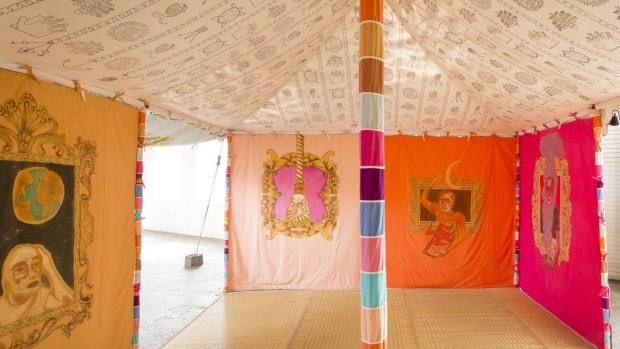
Intensive patterning with ribald, tantric imagery: Tent interior.
Nowadays Clemente's star doesn't shine quite so brightly. He is still represented by very good galleries, but not the very top. His paintings sell for handsome sums but his auction prices have fluctuated, and often dropped. His eclipse may be merely temporary, however.
Francesco Clemente: Encampment, the latest in a series of international shows at Carriageworks sponsored by art dealer Anna Schwartz, is a testament to the artist's undiminished powers of invention. The show consists of six large tents, produced in collaboration with a firm of master tent makers in Rasjasthan; four freestanding sculptures on the themes of Sun, Moon, Hunger and Earth; and 19 colourful, erotically charged watercolours.
This ensemble occupies the venue's cavernous spaces in a very natural way. Although we are only talking about 30 works, the tents are so packed with imagery that each feels like an exhibition in its own right. The watercolours and sculptures are equally compelling, seemingly filled with meaning but giving away few clues. It's classic Clemente – fascinating and obscure; polymorphously perverse; and utterly indifferent to anatomy, perspective, composition, and other conventions of western art.
To love Clemente's work one must be prepared to enjoy the spectacle of boneless, rubbery bodies disporting themselves in fleshy tangles; an abundance of silhouettes, animals and assorted symbols, brushed on with powdery tempera. For Clemente the image is everything, and technical skill of no account.
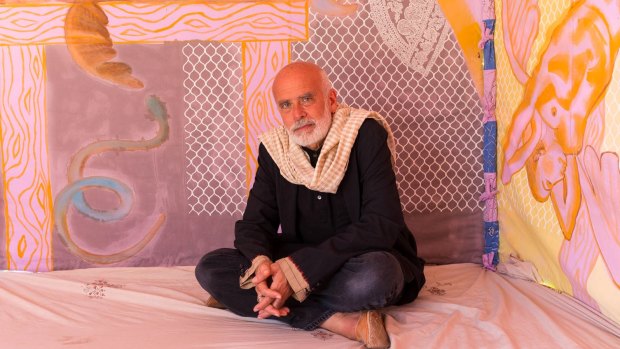
Francesco Clemente in his Angels' Tent in 2013.Credit: Neil Greentree
The late Robert Hughes loathed this style of drawing, and his put-down is worth quoting: "Clemente's work lives a tremulous, only partly decipherable life at the juncture of eros and cultural memory. It is rarefied, intelligent and decadent, although its intelligence is more literary than plastic and its decadence never fails to make collectors want to cuddle it."
In the 1980s there may have been some truth in this, when the artist was the darling of New York. His cryptic, erotic imagery acted as a tease for the semi-erudite. I have vague memories of a character resembling Clemente appearing in the pages of Tom Wolfe's satirical novel of 1987, The Bonfire of the Vanities.
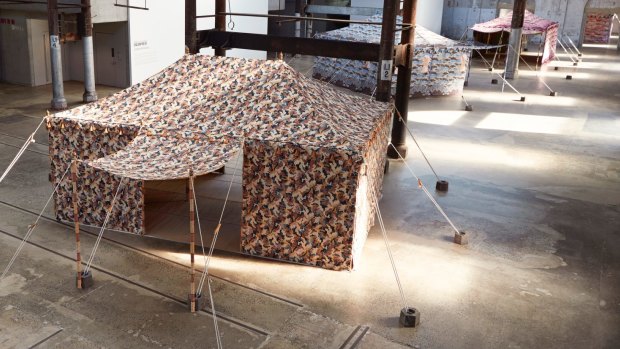
The exhibition occupies thecavernous spaces at Carriageworks in a very natural way.Credit: Zan Wimberley
Almost 30 years after Hughes's critique, the good points remain true but the sting has gone. Clemente's work still comes across as "rarefied, intelligent and decadent" but collectors are less inclined to bestow their affections. They have lost patience with the artist's cross-cultural paradoxes and opened their arms to purveyors of expensive, high-end product such as Jeff Koons and Damien Hirst. The fashion-victim collector who might have bought a Clemente in 1985 will now buy a Damien Hirst spot painting, made with a stencil by assistants and sold for several hundred thousand dollars, although they have reputedly gone for as much as $US3 million. A catalogue of 2014 lists 1,365 of these paintings, although many more have been produced since then.
It is difficult to argue such vacuous commodities are in any way superior to Clemente's multi-layered paintings. The market hype that infuriated Robert Hughes in the 1980s has escalated to the point that today's wannabee collectors are buying brands for astronomical prices. In such a market, Clemente's literary, historical and spiritual preoccupations seem absurdly fussy. Who needs content anyway?
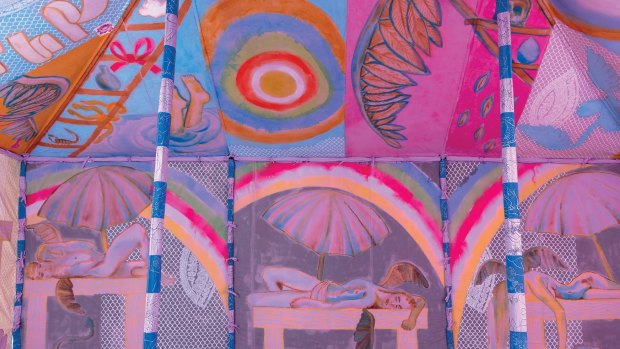
"Today's angels are tired": Angels' Tent (detail).
Clemente's work may have benefited from a little neglect. Away from the constant glare of publicity, he has continued to mine the same sources of inspiration, producing images that play games with viewers' minds. His Devil's Tent suggests that life is "a balance between Heaven and Hell", with Mephistopheles as a dandy with a top hat, cigar and monocle. The devil is a cartoon capitalist, an imperialist, a slave-trader – a figure who can "tilt the balance of good and evil with a minimal effort."
In the label for his Angels' Tent, Clemente says: "Today's angels are very tired. Indifference wears one out more than hate." The tent is filled with images of angels lying on tables beneath umbrellas, as if sleeping off a hangover at a beach resort, their wings drooping languidly. It's an image of a world in which nobody believes in angels any more or calls on their assistance.
His Taking Sides tent features seated Buddhas with the heads of predatory creatures. Each cradles a small animal in its arms, leaving us to ponder whether natural ferocity can be tamed by spiritual exercise, or if there is an irreconcilable contradiction between the teachings that take place in seclusion and the way the real world operates.
The 19 watercolours, made with the assistance of Indian miniature painters, contrast planes of neat, intensive patterning with ribald, tantric imagery produced by the artist with free swipes of the brush. The colours are strong and obviously chosen for their symbolic value, as in the headless torso of a woman divided into blue and red halves, or blue and red phalluses tied together by a ribbon. Clemente deals in dualities, depicting the sexual act as passive and aggressive, melancholy and passionate, and so on.
In another image a blank head is pierced by leafy twigs - or are they peacock feathers? - which leave trails of blood seeping from wounds. It may suggest that we grow receptive to the experience of nature when we empty our minds and become a vessel. But the process is portrayed as a violent penetration not a gentle coming together of entities.
The watercolours, tents and sculptures are riddled with ambiguities that Clemente is reluctant to dispel. He is fond of quoting De Chirico's line, written in Latin at the bottom of a self-portrait: "What shall I be able to love if not the unspoken mystery of things?"
What indeed? To disregard that mystery in favour of clear, concrete statements is to take away one of the prime reasons we can look at a work of art and find ourselves transported to another world.
FRANCESCO CLEMENTE: ENCAMPMENT
CARRIAGEWORKS, UNTIL OCTOBER 9